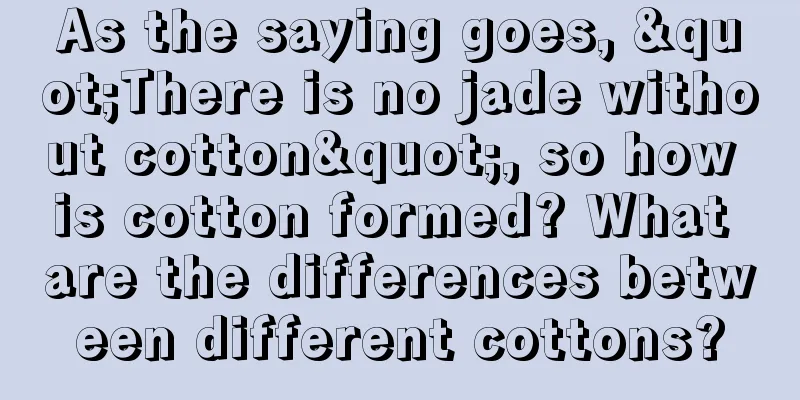As the saying goes, "There is no jade without cotton", so how is cotton formed? What are the differences between different cottons?

|
As the saying goes, "There is no jade without cotton". Cotton is the natural sign of jadeite. It is both a flaw and a feature. For example, the popular snowflake cotton, cotton, as the name suggests, It is the white cotton-like floc in jade. It often appears in the form of threads, lumps, mist, dots, etc. According to their causes, they can be divided into structural wool and mineral wool. So how is cotton formed? What are the differences between different cottons? 1. Structural cotton Structural cotton refers to the formation process of jade. Due to the different arrangement and relationship of jadeite minerals, This creates cracks or heals cracks between jadeite minerals. Under the light, it appears as clumps, blocks, strips, fog, etc. Depending on the characteristics, Structural cotton can be divided into micro-crack cotton, cotton caused by impurities and colored cotton at the microscopic level. 1. Micro crack cotton Different parts of jadeite are not exactly the same. Even within a piece of glass-type jadeite, there will be some loose structures in some areas. Where the gap is larger, Forming chaos, darkness, Depending on the shape of the structure, Produces cotton in different shapes. 2. Cotton caused by impurities Jade often contains foreign impurities. Some impurities are relatively large, while others are relatively small. Sometimes we gather together, sometimes we disperse. When they gather together, they form a mass of cotton. Like the dot-shaped cotton that is characteristic of Mu Na, when it is dispersed, Will wander in the cracks of the structure, When there are too many of them, the jade will look chaotic and dirty. This is the case with many jadeite found at the bottom of gray water. It’s just that the impurities in the cotton are also dirty. 3. Colored cotton Foreign impurities are often colored. It's not necessarily colorless. The dotted cotton in Muna is mostly colorless. It is the white cotton we commonly see. The so-called dead flowers that we often see now, It's actually colored cotton. The main performance is those with good blue flowers. Even those living flowers that look more lively, It's just that the smaller colored cotton is scattered. It looks more light, Basically, there is more cotton. 2. Mineral Wool Mineral wool is mainly the different mineral combinations produced by the crystallization differentiation of jadeite in the later stage. Especially containing albite, Due to the difference in refractive index between different minerals, and the different degrees of tightness of binding, When exposed to light, white cotton wool in the form of dots or clumps will form. Mineral wool mainly exists in the form of symbiotic or associated minerals of jadeite. It is distributed in irregular dots and clusters. It is mostly found in jadeite with fine texture. Such as ice with high transparency, It appears in oily green, blue water and black jadeite with good texture. For example, the Mu Na snowflake cotton that everyone is very familiar with. It can be seen that the presence of cotton will have an important impact on the quality of jade. First of all, cotton will affect the color of jade. The more cotton there is, the worse the light transmittance of the jadeite will be. The more it affects the color transmission; At the same time, the more cotton there is, the more concentrated it is. It will also affect the spread of color. Secondly, cotton will affect the quality of jade. That is the transparency of jadeite. Jade with a lot of cotton looks chaotic and dirty, has poor transparency, and appears a bit dull. Cotton is one of the important characteristics of jade that cannot be ignored. Correctly understand the cotton in jadeite. It is of great significance to evaluate the quality of jade and judge the authenticity of jade. Everyone should pay attention to learn more and understand more~
fruit fcgc33 |
<<: I heard that jade has a "taste", have you ever tasted it?
>>: What kind of jade is violet jade?
Recommend
How to choose jade cabochon, what you need to know when buying jade rings
Among jade products, plain products are more comm...
How many of the 10 benefits of wearing jade bracelets do you know?
More and more people are joining the ranks of jad...
There are many types of jadeite. Let us teach you how to recognize the types of jadeite.
Everyone knows that there are many types of jade,...
Black Jade: The “Scholar” among jades, who makes his own voice without making any noise!
In recent years, black jade has quietly appeared ...
Come and admire this jade Buddha carved from a piece of jadeite rough stone!
Today I would like to share with you a piece of H...
How are jadeite mountains carved? How should we appreciate jadeite mountains?
Jade mountain is a kind of jade ornament for indo...
How to polish and grind jadeite raw stone?
Today, jade is becoming increasingly powerful in ...
The simplest way to identify jadeite, it is useful after reading this article
Jadeite is known as the "king of jade" ...
If you don’t collect the jade carving masterpiece “Live Ring Chain Carving”, it will be gone!
Speaking of the jade carving technique of live ri...
Are the eight planets so beautiful? But the color of jade is beyond imagination
The vast starry sky, the reincarnation, the stars...
Black jade life, silent and natural
Ink color hides the edge Jade vessel in the belly...
How did jade come from? Deciphering the origin of jade
Jade has been loved by many people since ancient ...
Art Appreciation丨Take you closer to the world of jade!
Man takes care of jade for three years, and jade ...
Carving a "cicada" out of an ordinary jadeite stone, does it feel like jade carving is very simple?
Today I will show you the process of carving a &q...
Ten identification methods of jadeite, you will be an expert if you learn them
Jade is generally divided into three grades, A, B...









